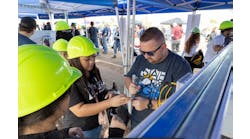The California Building Standards Commission adopted residential mandatory standards requiring new dwellings to have infrastructure for the future installation of electric vehicle charging stations. The standards are part of CALGreen (Title 24, Part 11) and require all new one- and two-family dwellings, townhouses with attached private garages, and multifamily dwellings of 17 or more units to provide the infrastructure.
One- and two-family dwellings and townhouses will require a minimum size one-inch raceway to be installed from the service panel or panelboard to the proposed EVSE location. The service panel or panelboard must also be of sufficient capacity for the future EVSE load and have a space to accommodate a 40A minimum overcurrent device.
New multifamily dwellings of greater than 17 units will require 3% of the total number of parking spaces provided, but not less than one, to have provisions for the future installation of electric vehicle charging stations. If only one charging station location is required, a minimum one-inch raceway must be installed from the main service or panelboard location to the EVSE location. If multiple stations are required, the construction documents must show the proposed design, including charging station locations, raceway locations and load calculations based on 40A minimum branch circuits. Proposed raceways must be installed at the time of original construction.
The new CALGreen standards will be effective on July 1, 2015. They can be viewed on the California Building Standards Commission website.



